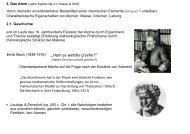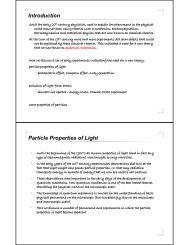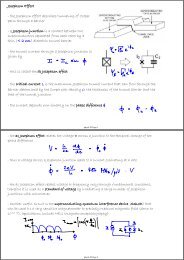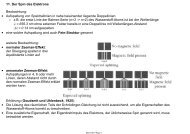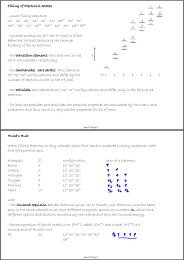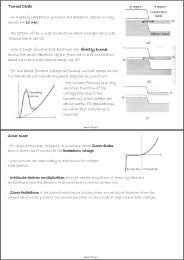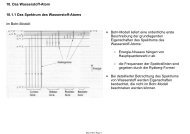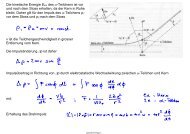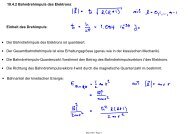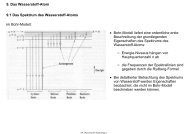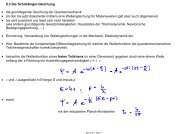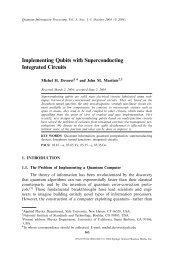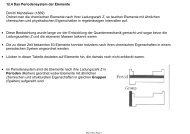Create successful ePaper yourself
Turn your PDF publications into a flip-book with our unique Google optimized e-Paper software.
<strong>Electron</strong> <strong>Orbits</strong><br />
• In an atom model in which negatively charged electrons move around a small positively<br />
charged nucleus stable orbits are possible.<br />
• Consider the simple example of an atom with a nucleus of charge of +e and one electron<br />
with charge –e on an orbit around it (like in the hydrogen atom).<br />
centrifugal force:<br />
electrostatic force:<br />
stability criterion:<br />
<strong>Binding</strong> <strong>Energy</strong><br />
kinetic energy of the electron<br />
on its orbit:<br />
potential energy:<br />
total energy:<br />
experimental result for the binding<br />
energy of Hydrogen (H):<br />
binding energy<br />
estimate of the radius of the electron<br />
orbit:
Radiation of <strong>Electron</strong> on Orbit<br />
electromagnetic power radiated by an<br />
charge moving with acceleration :<br />
centrifugal acceleration of electron on<br />
circular orbit:<br />
power radiated by electron in a hydrogen<br />
atom (r ~ 0.05 nm):<br />
• Under classical considerations this electron should loose its energy (-13,6 eV) very rapidly<br />
and drop into the nucleus (which would be very bad news).<br />
• Considering the wave-like properties of the electron however we will be able to explain (using<br />
the laws of quantum mechanics) why the electron moves on a stable orbit around the<br />
nucleus.<br />
Emission and Absorption of Light<br />
measuring the spectrum of light
Black Body Spectrum<br />
• fusion (H 2 -> He)<br />
• power ~ 100. 10 9 GW<br />
• temperature<br />
T ~ 6000 Kelvin<br />
• continuous spectrum<br />
• power on earth 1 kW/m 2<br />
• largest intensity in visible part<br />
of the spectrum<br />
Spectrum of the Sun
Spectra<br />
visible spectrum of hydrogen Na ()<br />
Sodium Doublet<br />
• transition between two electronic states with<br />
different orbital angular momenta L<br />
• evidence for electron spin due to spin-orbit<br />
coupling visible in total angular momentum j<br />
• naming convention of levels: n Lj
More Spectra<br />
• the sun<br />
• sodium (Na)<br />
• mercury (Hg)<br />
• lithium (Li)<br />
• hydrogen (H)<br />
Emission Spectra<br />
• hot and dense objects (solids) display continuous spectra (e.g. the sun)<br />
• the properties of a large number of interacting atoms (collisions) is observed<br />
in this case<br />
• frequently the spectrum can be explained using the ideas of black body<br />
radiation (to be discussed later)<br />
• the properties of individual atoms become apparent at low densities, when the<br />
interactions are small<br />
• then individual line spectra are observed<br />
• the properties of these spectra are characteristic for the different elements<br />
• both emission and absorption spectra can be observed
Spectral Series<br />
• in the late 19 th century it was found that spectral<br />
lines of simple elements can be ordered into simple<br />
series<br />
• one of the first ones was the Balmer (n=2) series of<br />
spectral lines in Hydrogen in the visible wave<br />
lengths.<br />
n=5<br />
n=4<br />
n=3<br />
n=2<br />
Balmer series<br />
n=1<br />
Bohr Model<br />
• If the electron orbit length would<br />
not be an integer multiple<br />
destructive interference would<br />
appear and the orbit would not be<br />
stable or even exist.
Quantum Numbers in the Bohr Model<br />
<strong>Energy</strong> Levels of the Hydrogen Atom<br />
total energy of electron as calculated before with n th Bohr<br />
radius:<br />
with Rydberg constant<br />
The set of different energies are the of the<br />
hydrogen atom. is the energy<br />
corresponding to the quantum number . are<br />
energies with the corresponding quantum<br />
numbers.
Spectral Lines and Transitions in Hydrogen<br />
Excitation, Relaxation and Lifetime<br />
atoms are excited into higher energy states<br />
• by collisions with electrons or other atoms(Franck-Hertz<br />
experiment)<br />
• by absorption of photons (c.f. absorption spectra)<br />
after some time the atoms relax (decay) back to the ground state<br />
the life time of an excited state<br />
• is limited by spontaneous emission (coupling to vacuum<br />
fluctuations, Einstein A coefficient to be discussed later)<br />
• the emission can also be induced by interactions with other<br />
photons, collisions with electrons or other atoms<br />
• a wide range of life times is observed, a few nanoseconds to<br />
minutes (if you are very careful)
Experiment of Franck and Hertz<br />
vacuum tube with mercury (Hg) vapor<br />
experimental set up<br />
original measurement result<br />
• The experiment demonstrates that atoms absorb energy from collisions with<br />
electrons in quanta that are determined by the atoms energy level structure<br />
given by the laws of quantum mechanics.<br />
Nobel Prize in Physics (1925): Franck and Hertz<br />
"for their discovery of the laws governing the<br />
impact of an electron upon an atom"<br />
James Franck<br />
1/2 of the prize<br />
Germany<br />
Goettingen University<br />
Goettingen, Germany<br />
b. 1882<br />
d. 1964<br />
Gustav Ludwig Hertz<br />
1/2 of the prize<br />
Germany<br />
Halle University<br />
Halle, Germany<br />
b. 1887<br />
d. 1975
Experimental Setup<br />
Spectrum of Neon<br />
• excitation<br />
by electron<br />
collision<br />
• highly excited electronic states<br />
• transitions in the visible<br />
frequency range<br />
• lower excited electronic states<br />
ground state
Comment of Franck on their Experiment<br />
"It might interest you to know that when we made the experiments that we did not know Bohr's<br />
theory. We had neither read nor heard about it. We had not read it because we were negligent to<br />
read the literature well enough -- and you know how that happens. On the other hand, one would<br />
think that other people would have told us about it. For instance, we had a colloquium at that<br />
time in Berlin at which all the important papers were discussed. Nobody discussed Bohr's<br />
theory. Why not? The reasons is that fifty years ago, one was so convinced that nobody would,<br />
with the state of knowledge we had at that time, understand spectral line emission, so that if<br />
somebody published a paper about it, one assumed, "Probably it is not right." So we did not<br />
know it. But we made that experiment (and got the result that confirmed Bohr's theory) because<br />
we hoped that if we found out where the borderline between elastic and inelastic impact lies ...<br />
only one line might appear. But we did not know whether that would be so, and we did not know<br />
whether at all an emission of an atom is of such a type that one line alone can be emitted and<br />
all the energy can be used for that purpose. The experiment gave it to us, and we were surprised<br />
about it. But we were not surprised after we read Bohr's paper later, after our publication."<br />
-- Excerpt from one of three recordings of J. Franck, made in connection with a film on the Franck-Hertz<br />
experiment at Educational Services, Inc., Watertown, Massachusetts, in January, 1961. As transcribed in<br />
"On the recent past of physics", by Gerald Holton, American Journal of Physics, vol. 29, p. 805 (1961).<br />
Correspondence Principle<br />
• The prediction of quantum theories, like the (maybe too) simple Bohr model, should<br />
correspond to the predictions of classical theories in the limit of large quantum numbers.<br />
This fact is called the correspondence principle.
Hydrogen-Like Atoms<br />
extension of Bohr model to other atoms with a single electron He + , Element (Z-1)+<br />
energy levels in potential scaled with atomic number



